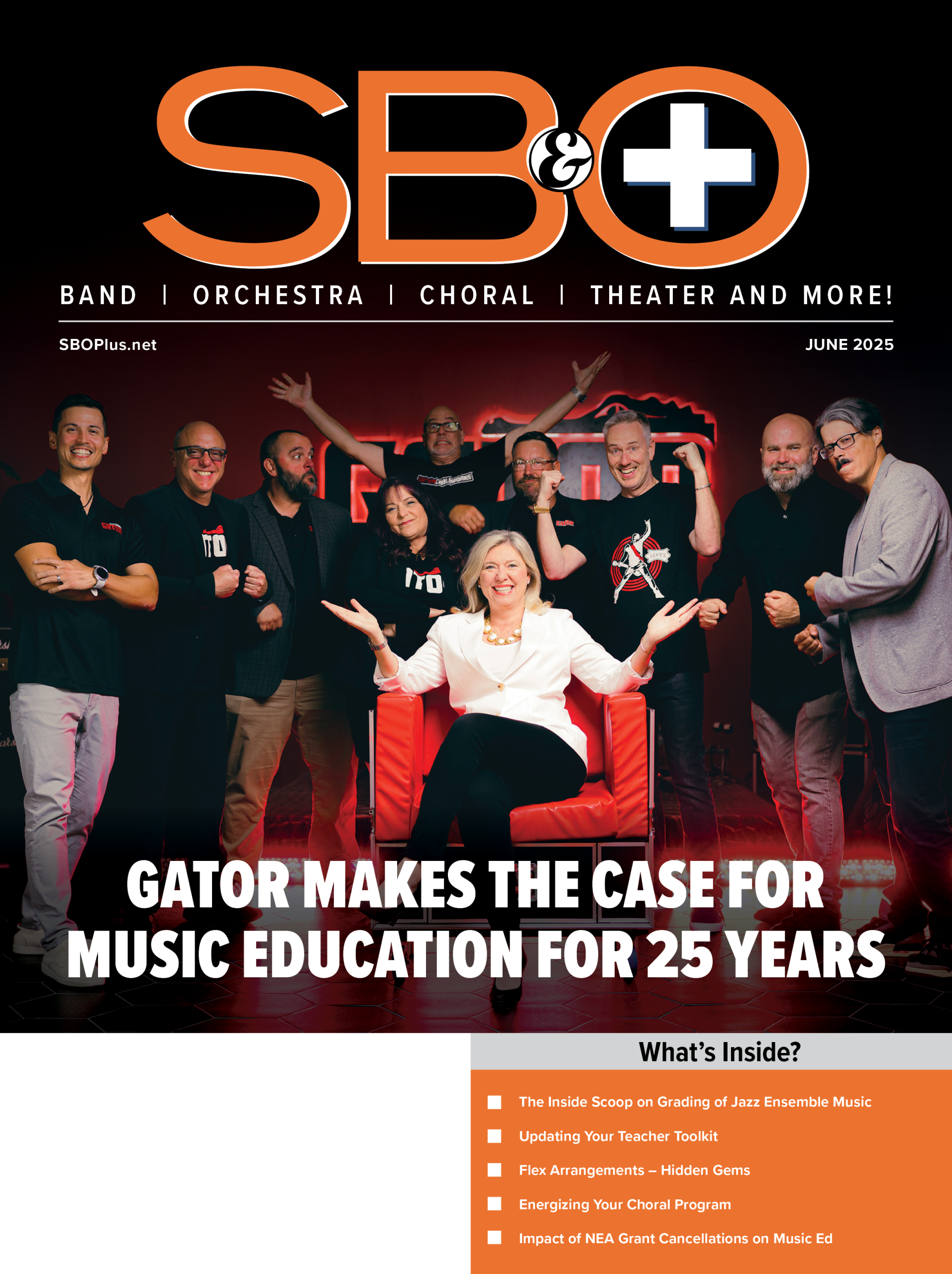Orchestra, Concert Band and Marching Band are the staples of music education programs across the country, but small ensembles just may be the glue.
“It is one of the most important aspects of a quality program, as it puts musical responsibility more squarely on the individuals and allows for more individual expression than larger ensembles often do,” points out Jim Lewis, director at Charles D. Owen High School in Black Mountain, N.C.
A recent survey of band and orchestra directors, conducted by School Band and Orchestra, revealed that a whopping 90 percent of the survey participants’ programs also include a jazz band. Sixty-four percent of those surveyed have percussion ensembles. Thirty-three percent have a string or chamber ensemble. Woodwind ensembles – from saxophone quartets to flute choirs – can be found at 45 percent of the participants’ schools. Brass ensembles – including euphonium quartets, French horn choirs and holiday brass – are also popular, according to 52 percent of the directors surveyed.
The term “small ensemble” does not translate into low participation or lack of interest. Only 1 percent of the directors surveyed have fewer than 10 students participating in small ensembles, while 20 percent have more than 75 students taking part in the various small ensembles in their programs. On average, music programs have 30 to 40 students involved in small ensembles.
Getting Started
While all of the directors who responded to the survey expressed enthusiasm about forming small ensembles, 10 percent of the directors surveyed had this zealous advice: “Go for it!”
“Do it! Small ensembles improve musicianship and with greater effect than large ensembles,” says James A. Martini, director of bands at Central York High School in York, Penn.
Getting started is the hardest part, notes Tom Meyer, director of Nevada bands in Nevada, Mo.
“Get music and a regular rehearsal time and begin. You don’t always have to use your top musicians. Other students will appreciate the opportunity and surprise you with their effort.”
But once the ensemble has been assembled and the students are on board, the rest should take care of itself.
“Don’t worry about ‘teaching’ too much at first. Get them to play and spark the interest, then the teaching of improvisation and other things will naturally occur,” says Josue Perez, director at Aurora High School in Aurora, Ohio.
Another 10 percent of directors stressed the importance of “starting easy,” to generate interest and confidence.
“Start simple, having the group read some easier pieces to learn how to blend musically together first. Do this before assigning a challenging piece. Teach the young students to play together first before giving them a piece that requires a lot of self-practice,” explains Jan Hare, director of bands at Delphos St. John’s Schools in Delphos, Ohio.
Starting simple helps the students develop listening skills and learn how to balance. But don’t linger too long at the “easy” stage.
“Quickly move onto some interesting pieces and provide many opportunities to perform. Small ensemble playing develops skill and confidence, and audiences love to listen to them. It helps weaker players develop and lets the strong players shine,” observes Geri Peterson, director at Huron Middle School in Huron, S.D.
The Fun Factor
Making small ensembles fun and accessible for the students also ranked high among directors, with 6 percent using those exact words: “Make it fun.” From letting the students select their favorite music to rewarding ensemble members with extra credit, survey participants’ ideas for “making it fun” ran the gamut.
Joan Elson Moore, director at Glenbard North High School in Carol Stream, Ill., offers this example of how her students’ ensembles have taken fun to a new level.
“Make it fun – have food occasionally, suggest ways it can become a club as well as a performance opportunity. For example, a group from the percussion ensemble got together on their own and went to see ‘Blast!’ The guitar ensemble is partial to nachos and having ‘electric guitar days.’ “
While the ensemble may be fun and rewarding for the students, it will require extra work and patience from the director. But it’s worth it, according to the majority of directors surveyed.
“Be willing to teach the ensemble on your own time,” recommends Denise A. Kuehner, orchestra director at Clay High School in South Bend, Ind. “The school will rarely pay you to do extra things like coach ensembles, but it is so important to the students’ musical and social development. You will see more growth through chamber ensembles than through regular band and orchestra class because the individual is just that – an individual. He or she is responsible for their own part, and that sense of ownership makes them a more valuable contributor to the large ensemble in the long run.”
Writing additional parts to suit the ensemble’s instrumentation may fall into the “extra work” category.
“Don’t be afraid to write out parts for other instruments to make an ensemble happen,” urges Craig Incontro, director of bands at Amherst Central High School in Amherst, N.Y. “Cello players playing bassoon parts work just fine in woodwind quintet music. Be sure to look at the woodwind octets of Mozart, Haydn and Beethoven.”
Getting the Students Involved
Among the advice directors offered about how to start a small ensemble, 12 percent emphasized the importance of student involvement. Directors agree that if an ensemble is student-driven, it is much more likely to succeed.
“Get the kids excited about the sound of their own instrument and then let them have fun putting the ensemble together,” advises Douglas A. Kelley, director of bands at Centennial High School in Bakersfield, Calif. “I found that the more input the students have with small ensembles, the more focused they become. My students help choose literature and help set the performance calendar.”
A student-driven ensemble can still use the input of the director.
“Allow students to select their ensemble members and formats, provided they fall within traditional instrumentation. Also, allow them to select the music from a list that you have compiled. That way, you can know that they are doing something worthwhile. They won’t have to sift through the myriad of pieces available. The students will feel more in charge of their own ensemble, which will add to the energy level, enthusiasm and commitment to the music and the ensemble,” says Adam Hollingsworth, who teaches at Win-E-Mac Public School in Erskine, Minn.
To really drum up interest in a new ensemble, directors may need to enlist the assistance of student leaders and other “instrumental” band and orchestra members.
“Find a ‘fired-up’ student, like a drum major or future college music major, to assist running the ensembles,” suggests Scott F. Pries, director at Imlay City High School, in Imlay City, Mich. “These kinds of students are always looking for more to do in the band room.”
Performances
One of the advantages to small ensembles is that they are more easily portable than, say, a 100-piece marching band or a full orchestra of 140 players. This means they can perform more often and at a variety of venues – not just in the school auditorium or down Main Street. And because they can, directors agree, they should.
“Get them a gig. Nothing motivates better than knowing a public performance is scheduled,” notes Todd L. Hunter in the Dallas, Penn., School District.
According to SBO‘s survey, performance opportunities for small ensembles can be found just about everywhere. In addition to concerts, festivals, competitions and school events, 57 percent of the directors who participated in the survey said their small ensembles perform at a variety of community events and locales: fundraisers, dances, retirement homes, hospitals, grand openings, arts and crafts shows, Rotary Club meetings and the Special Olympics, to name a few.
Several directors take their brass choirs “caroling” during the holidays at shopping malls. Sandra L. McCormick, at Brewer High School in Fort Worth, Texas, has the right idea. Her ensembles perform “basically anywhere we can.”


























